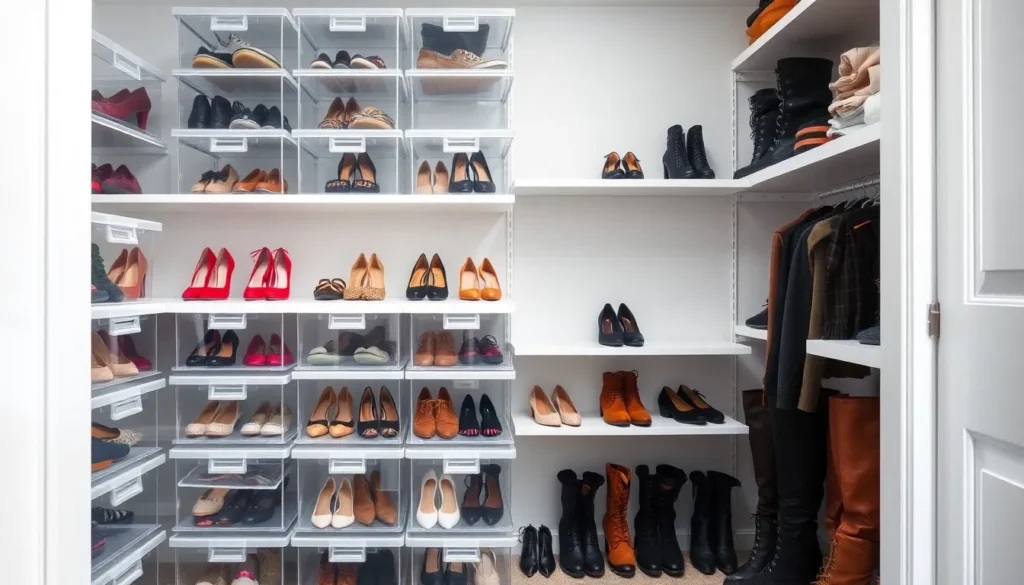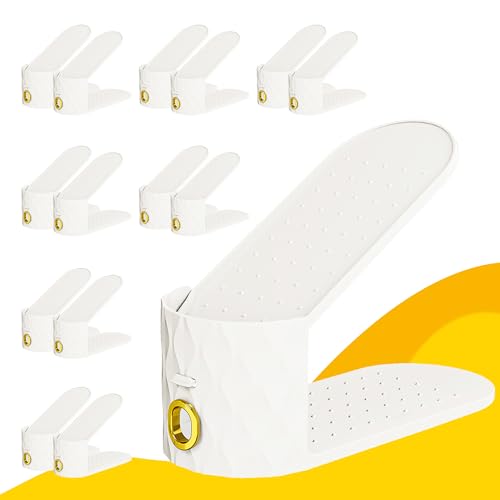We’ve all been there – standing in front of a chaotic shoe collection wondering how our once-organized closet turned into a footwear disaster zone. Whether you’re dealing with sneakers scattered across the floor or heels buried under piles of boots, finding the right pair shouldn’t feel like an archaeological dig.
The truth is, an organized shoe closet isn’t just about aesthetics – it’s about saving time, protecting your investment, and reducing daily stress. When your shoes have designated homes, you’ll spend less time searching and more time strutting out the door with confidence.
We’re sharing game-changing organization strategies that work for any space and budget. From maximizing vertical storage to creating systems that actually stick, these proven methods will transform your shoe chaos into a Pinterest-worthy display that makes getting dressed a pleasure instead of a chore.
Clear Out Your Shoe Collection First
Before diving into any organizational system, we need to tackle the foundation of effective shoe closet management. Decluttering creates the space and clarity necessary to carry out lasting organizational answers.
Sort Through Every Pair You Own
Empty your entire shoe collection onto a clean surface where you can see everything at once. We recommend using your bed or living room floor to create adequate sorting space. Pull shoes from closets, entryways, under beds, and any other hiding spots throughout your home.
Create three distinct piles as you examine each pair: keep, donate, and discard. Handle every shoe individually to make conscious decisions about its place in your collection. This process helps you rediscover forgotten pairs and identify duplicates you might not have realized you owned.
Group similar styles together within your keep pile to visualize how many dress shoes, sneakers, boots, and sandals you actually own. Seeing identical or nearly identical pairs side by side makes it easier to eliminate redundancy. We often discover we have multiple black pumps or several pairs of white sneakers that serve the same purpose.
Donate or Discard Worn Out Shoes
Examine the condition of each shoe by checking for worn soles, damaged heels, torn fabric, or broken hardware. Shoes with holes, separating soles, or important structural damage belong in the discard pile. We shouldn’t hold onto footwear that can’t be repaired or poses safety risks.
Donate shoes in good condition that no longer fit your lifestyle or personal style preferences. Clean them thoroughly before donation to ensure they’re ready for their next owner. Many charitable organizations, homeless shelters, and women’s shelters actively seek quality footwear donations.
Consider repair costs versus replacement value for shoes with minor damage like scuffed leather or loose stitching. High quality leather shoes often justify professional repair, while inexpensive casual shoes typically cost more to fix than replace. We recommend setting a repair budget threshold based on the shoe’s original purchase price.
Keep Only What You Actually Wear
Apply the one year rule by removing any shoes you haven’t worn in the past 12 months. These unworn pairs take up valuable storage space without serving your daily needs. Exception applies only to specialty items like formal event shoes or seasonal footwear with limited wearing opportunities.
Evaluate your current lifestyle needs against the shoes you’re considering keeping. Someone working from home doesn’t need five pairs of office appropriate heels, while an active person requires functional athletic shoes over decorative options. We should align our shoe collection with our actual daily activities.
Set a realistic number limit based on your available storage space and wearing patterns. Most people regularly rotate between 10 to 15 pairs of shoes throughout different seasons and occasions. Establishing this boundary prevents future accumulation and maintains the organized system you’re about to create.
Maximize Vertical Space With Shoe Racks
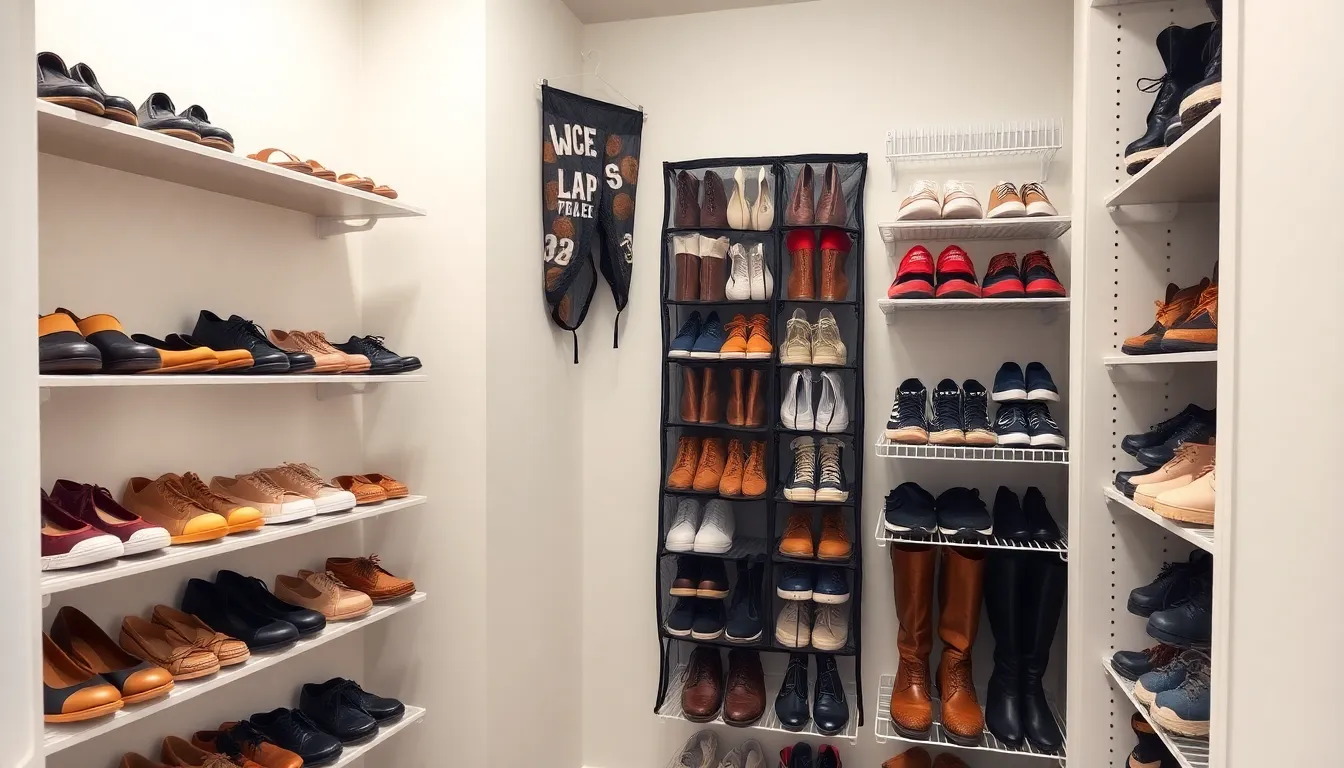
Vertical storage transforms cramped shoe areas into organized displays that showcase your collection beautifully. We’ll explore three proven methods that work in any closet size.
Install Wall-Mounted Shoe Shelves
Wall mounted shelves create dedicated storage that keeps shoes off the floor while maximizing your closet’s height potential. These shelves work particularly well for displaying frequently worn pairs since they provide easy visibility and access. We recommend installing them at varying heights to accommodate different shoe styles, from flats to boots.
Floating shelves offer a clean aesthetic that doesn’t overwhelm smaller spaces. Position them strategically above hanging rods or in unused wall areas to create additional storage without sacrificing floor space. The elevated placement also makes cleaning around your shoes much easier while protecting them from dust and moisture.
Use Over-the-Door Shoe Organizers
Over the door organizers with multiple pockets maximize unused space behind closet doors without requiring tools or permanent installation. These versatile answers can hold up to 24 pairs depending on the model, making them perfect for apartments or rental properties where modifications aren’t allowed.
Pocket organizers work best for lightweight shoes like sneakers, flats, and sandals. We suggest using the top pockets for accessories like shoe care supplies or less frequently worn pairs. The transparent or mesh design lets you quickly identify shoes without opening each compartment.
Stack Adjustable Shoe Racks
Stackable racks offer flexibility that grows with your collection since you can add levels as needed. These adjustable systems work exceptionally well in walk in closets where you have room to build upward. We’ve found that tiered designs make the most efficient use of vertical space under hanging clothes.
Adjustable features let you customize shelf heights for boots, heels, or athletic shoes. Stack two or three units to create a tower that holds 12 to 18 pairs while maintaining easy access to each level. The modular design means you can reconfigure the setup as your storage needs change.
Organize Shoes by Category and Frequency
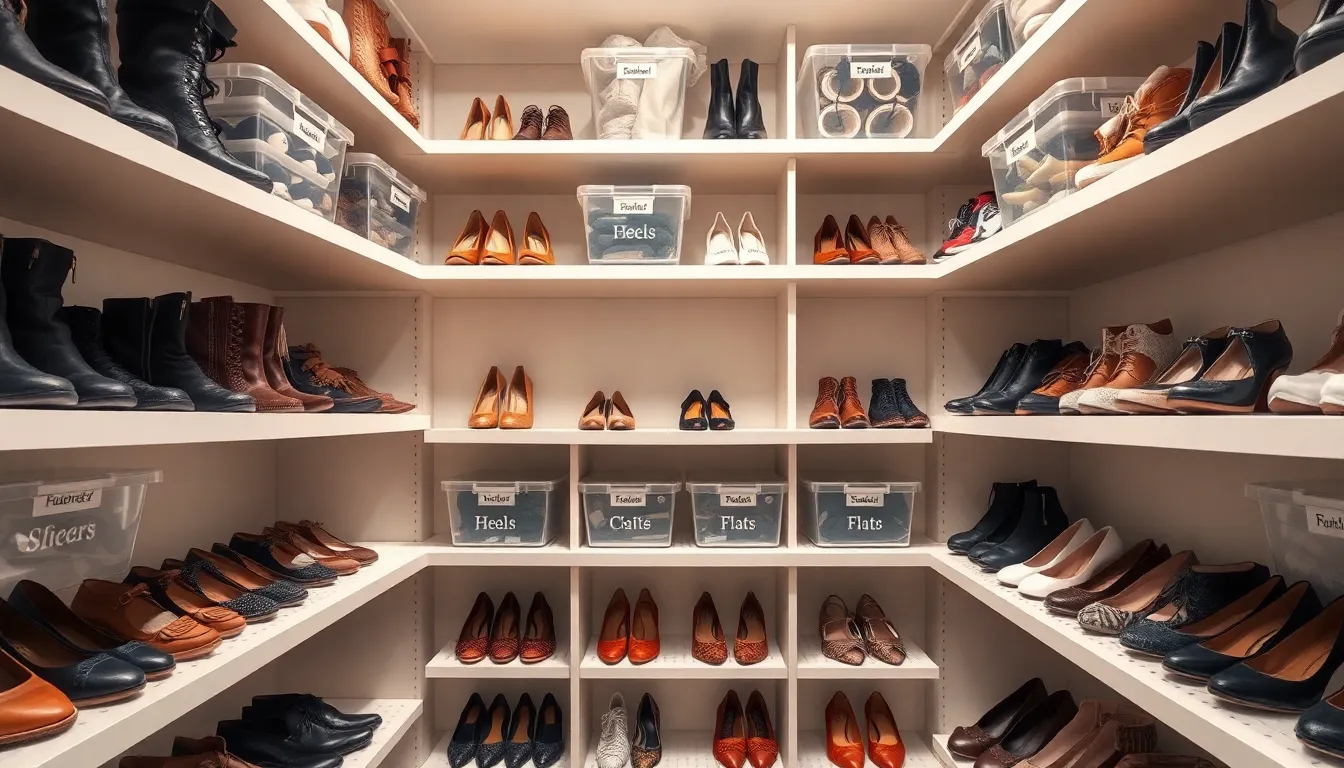
Creating a logical system for your shoe collection starts with smart categorization and strategic placement based on how often you wear each pair.
Group Similar Shoe Types Together
Separating shoes into distinct categories transforms a chaotic closet into an organized system that saves time during your daily routine. We recommend creating exact zones for boots, heels, flats, sneakers, and sandals to streamline your selection process. Athletic shoes work best grouped together since they’re often chosen based on exact activities like running, cross training, or casual wear.
Professional footwear deserves its own dedicated section where dress shoes, pumps, and formal boots can maintain their shape without crowding. This approach prevents scuffing between different shoe types and makes outfit coordination more efficient. Business casual options like loafers and low heels fit naturally in this professional category.
Seasonal groupings within each category help you quickly identify appropriate footwear for current weather conditions. Winter boots stay together while summer sandals occupy their own space, making seasonal transitions smoother throughout the year.
Place Daily Shoes at Eye Level
Eye level placement ensures your most frequently worn shoes remain easily accessible without requiring you to bend down or reach overhead. We position everyday sneakers, work shoes, and go to options at this prime real estate level for maximum convenience. This strategic positioning reduces physical strain and encourages you to maintain your organizational system.
Daily rotation shoes like comfortable flats, walking sneakers, and reliable work pumps deserve the most accessible spots in your closet. These workhorses of your wardrobe should never require hunting or digging to locate. Consider that most people wear 20% of their shoes 80% of the time, making this placement crucial for daily efficiency.
Visual accessibility at eye level also helps you remember what options you have available, preventing duplicate purchases and encouraging you to wear shoes you might otherwise forget about.
Store Seasonal Shoes on Higher Shelves
Higher shelf storage maximizes your closet’s vertical space while keeping seasonal items organized and protected until needed. We recommend dedicating upper shelves to winter boots during summer months and sandals during colder seasons. This rotation system keeps your prime storage areas focused on currently relevant footwear.
Protective storage containers work exceptionally well on higher shelves since seasonal shoes need dust protection during their dormant months. Clear bins allow you to identify contents quickly while maintaining organization. Label each container with the season and shoe type for effortless seasonal transitions.
Less frequently worn specialty shoes like formal event heels, hiking boots, or vacation sandals also belong on higher shelves. These occasion exact pairs don’t need daily accessibility but deserve proper storage to maintain their condition when needed.
Utilize Clear Storage Containers for Visibility
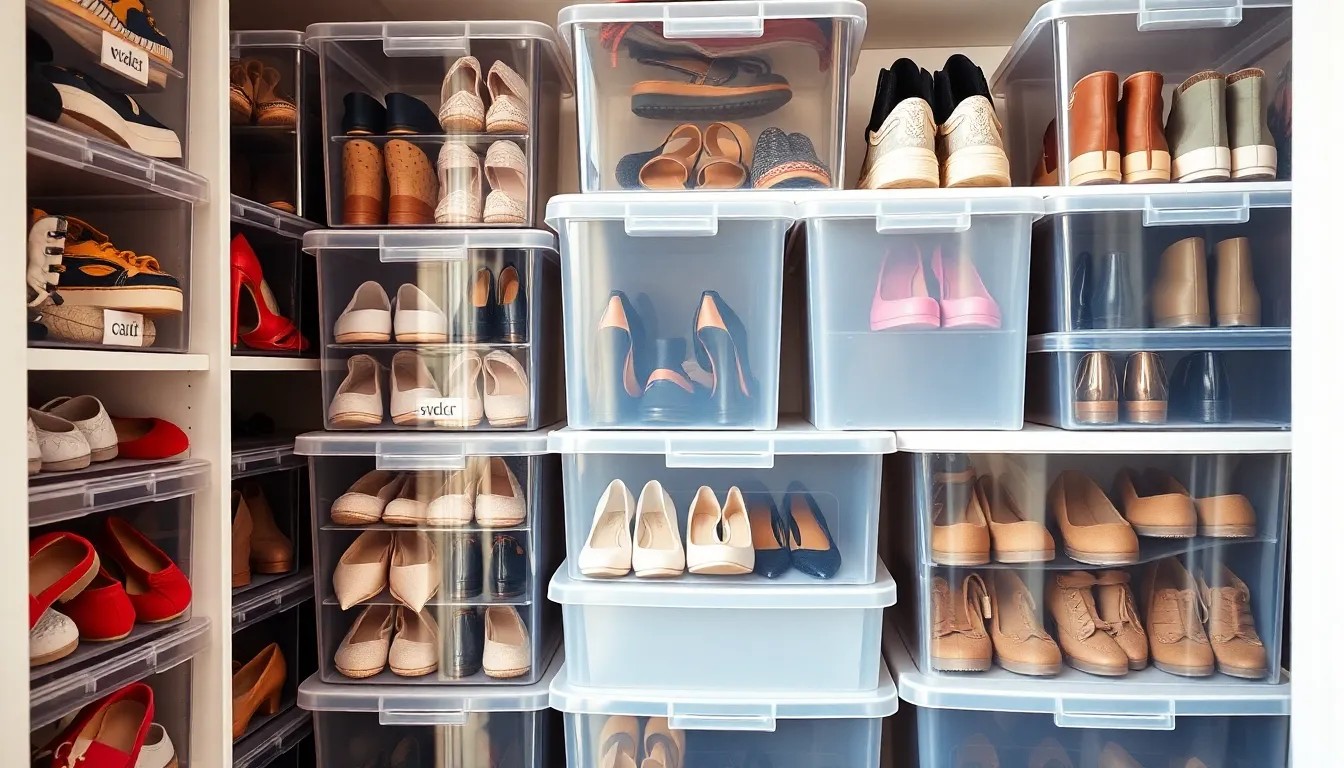
Clear storage containers transform your shoe organization system by creating a visible inventory that eliminates guesswork. We’ve found that transparent answers make finding exact pairs effortless while maintaining protection for your footwear investment.
Choose Transparent Shoe Boxes
Transparent shoe boxes offer the perfect balance of visibility and protection for your organized collection. We recommend selecting clear plastic containers that allow you to identify each pair instantly without opening multiple boxes. These protective barriers shield your shoes from dust accumulation and potential scuff marks while maintaining easy access.
Quality transparent boxes stack securely and withstand regular handling better than flimsy alternatives. We’ve discovered that investing in sturdy clear containers saves time during your daily shoe selection routine. Each box creates a individual showcase for your footwear while preventing damage from other items in your closet space.
Label Each Container Clearly
Labeling each transparent container enhances your organization system’s efficiency even further. We suggest using waterproof labels that clearly identify the shoe type, color, or occasion to speed up your morning routine. Strategic labeling becomes particularly valuable when containers are stacked high or stored in less accessible areas.
Consider using color-coded labels that correspond to different categories like work shoes, athletic footwear, or special occasion pairs. We’ve found that consistent labeling systems help maintain organization over time and make it easier for family members to return shoes to their designated spots.
Stack Boxes for Maximum Efficiency
Stacking clear shoe boxes optimizes your vertical closet space while maintaining easy access to your entire collection. We recommend creating stable stacks by placing heavier shoes in bottom containers and lighter pairs toward the top. This weight distribution prevents toppling and ensures safe storage for all your footwear.
Strategic stacking arrangements maximize your available space without sacrificing functionality. We suggest keeping frequently worn shoes in easily accessible middle stacks while storing seasonal footwear higher up. Each stack becomes a organized tower that transforms cramped closet areas into efficient storage answers.
Create Designated Zones for Different Activities
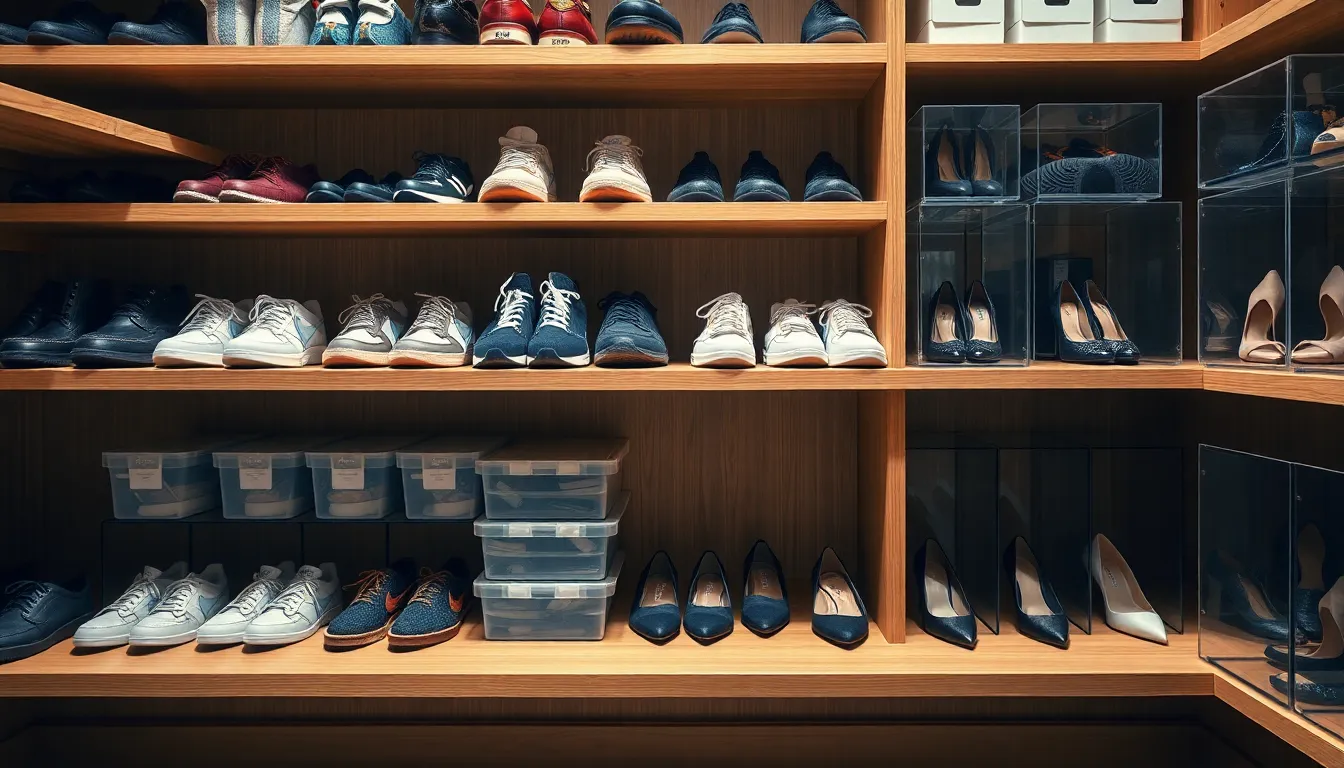
Organizing your shoe closet by activity transforms chaos into efficiency. Each zone serves a exact purpose while making daily selection effortless.
Establish a Work Shoe Section
Dedicate a designated section for work shoes to maintain professionalism and extend footwear lifespan. Lower shelves work perfectly for dress shoes and loafers since you’ll access them frequently during weekdays.
Position your work shoes near eye level for easy morning selection. Professional footwear like oxfords, pumps, and dress boots deserve their own space to prevent scuffing from casual shoes.
Store work shoes in designated boxes or on dedicated lower shelves for maximum accessibility. This placement ensures you won’t damage delicate leather while searching through piles of sneakers.
Consider rotating seasonal work shoes monthly to keep appropriate options visible. Summer work sandals shouldn’t compete with winter dress boots for prime real estate.
Set Up an Athletic Shoe Area
Create a dedicated space for athletic shoes to separate active footwear from formal options. Higher shelves or stackable containers work excellently for sneakers and running shoes since their rubber soles can handle more handling.
Group athletic shoes by activity type within this zone. Running shoes, cross trainers, hiking boots, and gym sneakers each serve different purposes and deserve distinct spaces.
Use stackable containers to maximize vertical space for bulky athletic footwear. These containers protect shoes from dust while allowing you to see exactly which pair you need for today’s workout.
Position frequently used athletic shoes on easily accessible shelves. Weekend warriors will appreciate having their go to sneakers within arm’s reach rather than buried behind seasonal boots.
Design a Special Occasion Shoe Space
Set aside a premium section for formal and special occasion shoes to protect your investment pieces. Clear boxes or display shelves showcase heels, dress boots, and statement shoes while keeping them pristine.
Store special occasion shoes on higher shelves since you’ll access them less frequently. Wedding shoes, formal heels, and party boots can live in protective clear containers until needed.
Display your most beautiful pairs on open shelves to create visual interest. Patent leather pumps, metallic heels, and designer boots deserve to be showcased rather than hidden away.
Use clear storage boxes for delicate formal shoes to prevent damage from daily handling. These protective containers keep dust away while allowing you to admire your collection through transparent walls.
Implement Smart Storage Solutions for Small Spaces
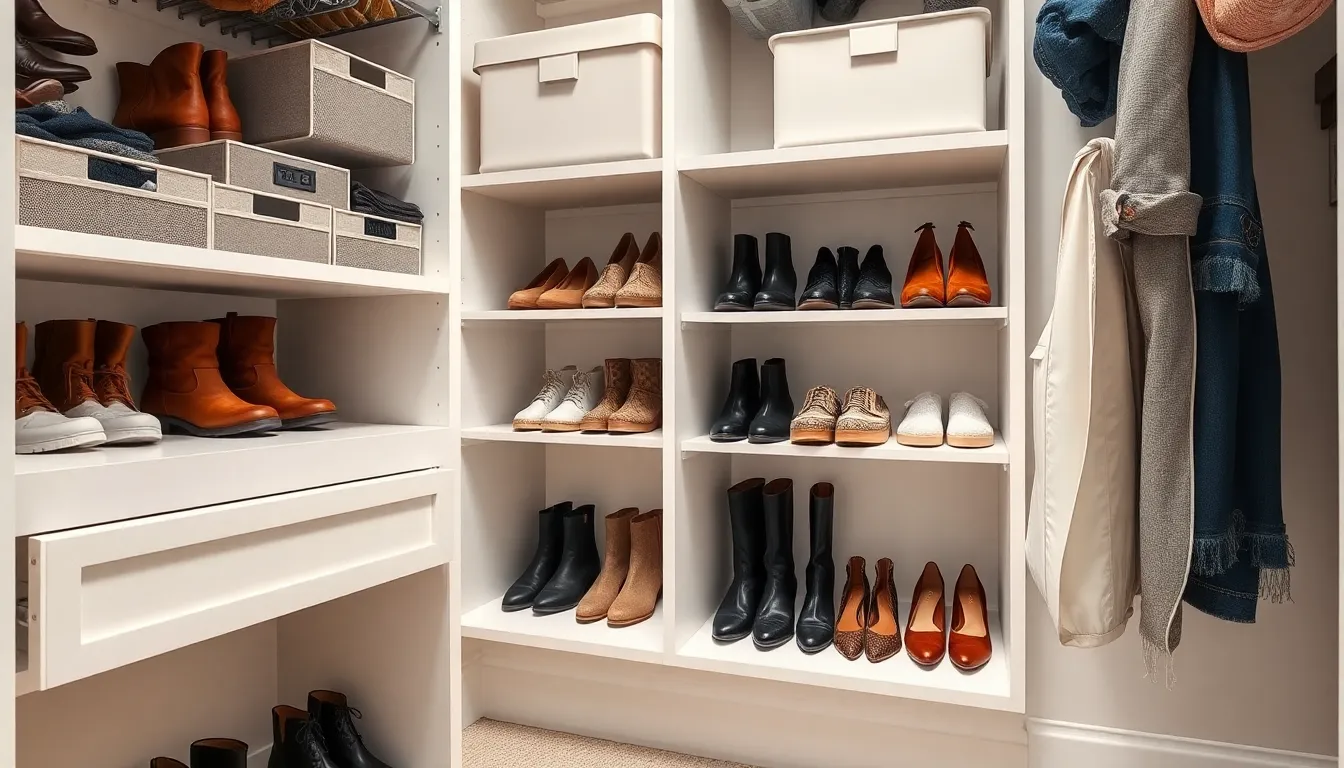
Maximizing every inch of your closet becomes essential when space is at a premium. Smart storage answers help transform cramped areas into organized shoe havens without requiring major renovations.
Use Under-Shelf Shoe Organizers
Under-shelf organizers capitalize on the vertical space beneath hanging clothes that typically goes unused. Tiered shoe racks slide perfectly into these gaps, allowing you to store multiple pairs of sneakers or sandals without sacrificing hanging space above.
Adjustable under-shelf storage bins work exceptionally well for seasonal footwear rotation. These bins keep out-of-season shoes dust-free while remaining easily accessible when weather changes. We recommend measuring your under-shelf clearance before purchasing to ensure proper fit.
Double-tier organizers maximize storage capacity by creating two levels within the same footprint. This design works particularly well for flats, loafers, and low-profile shoes that don’t require important vertical clearance.
Install Pull-Out Shoe Drawers
Pull-out drawers eliminate the frustration of digging through closet depths to find exact pairs. Built-in custom drawers integrate seamlessly with existing closet systems, providing dedicated storage for dress shoes, boots, and athletic footwear.
Retrofit drawer systems offer flexibility for renters or those avoiding permanent modifications. These units slide along existing shelves, extending fully for complete access to stored shoes. We’ve found that clear-front drawers work best for quick identification.
Deep-pull mechanisms accommodate boots and high-top sneakers without compromising accessibility. Professional installation ensures proper weight distribution and smooth operation for years of reliable use.
Hang Shoe Bags on Closet Rods
Shoe bags suspended from closet rods use otherwise wasted vertical space above hanging clothes. Clear vinyl organizers with individual pockets keep shoes visible while protecting them from dust and damage.
Over-the-rod designs work particularly well for frequently worn flats, sandals, and lightweight sneakers. These organizers hang securely without additional hardware, making them perfect for rental properties or temporary storage answers.
Canvas shoe bags with breathable fabric prevent moisture buildup while maintaining shoe shape. We recommend choosing organizers with reinforced seams and sturdy grommets to handle regular use without tearing or sagging.
Maintain Your Organized Shoe Closet System
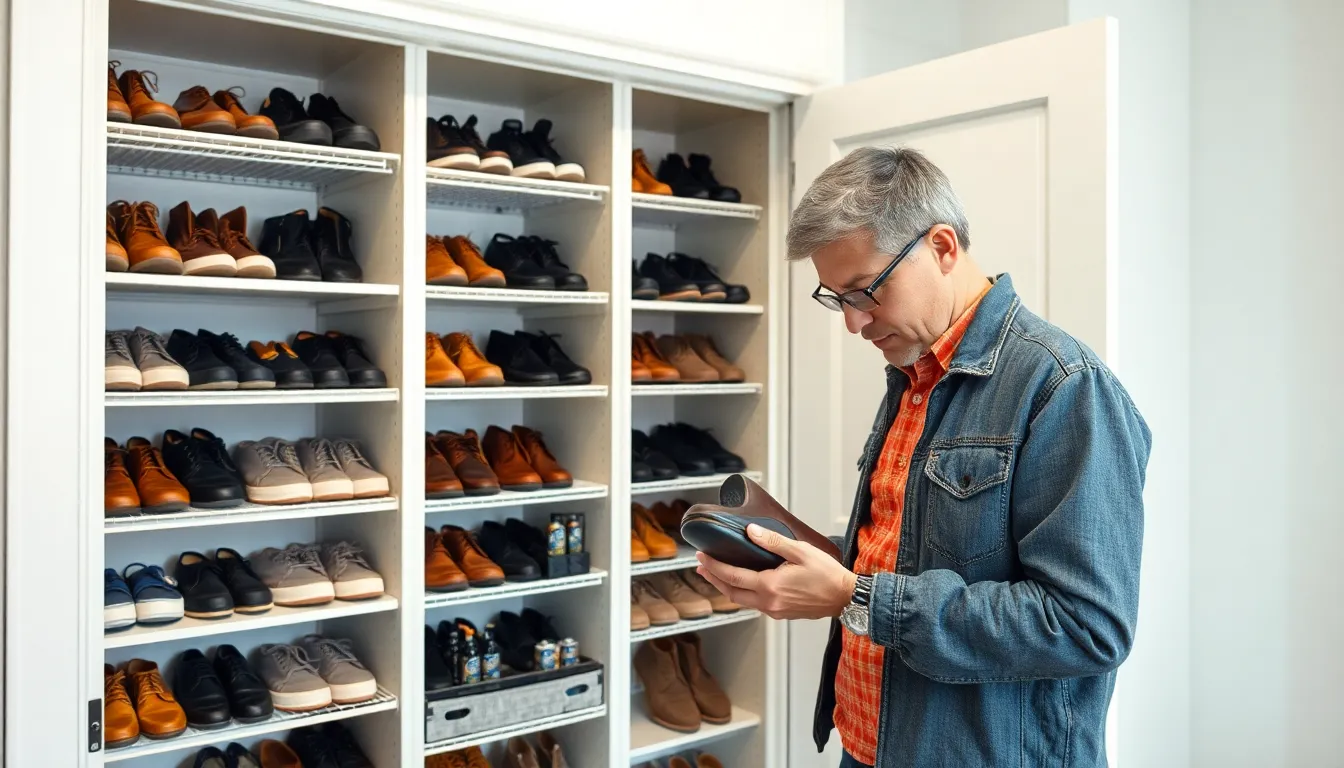
Building a well-organized shoe closet is just the beginning. Sustaining that organization requires consistent maintenance habits that prevent clutter from returning.
Establish a One-In, One-Out Rule
Maintain your closet’s capacity by removing an old pair whenever you bring home a new one. This simple strategy prevents accumulation and keeps your storage answers from becoming overcrowded. We recommend selecting the least-worn pair from the same category when making room for fresh additions.
Carry out this rule immediately upon purchasing new footwear to avoid decision fatigue later. Store the removed shoes in a donation bag rather than leaving them in your bedroom or entryway. Consider photographing shoes you’re unsure about removing so you can make final decisions without physical clutter.
Apply the rule to seasonal transitions by swapping out-of-season shoes for current weather appropriate options. This rotation maintains your closet’s capacity while ensuring you’re only storing relevant footwear in prime storage locations.
Clean and Reorganize Monthly
Schedule monthly clean and reorganize sessions to review and tidy up your closet system before small issues become major problems. We suggest choosing the same day each month, such as the first Saturday, to establish a consistent routine. This regular maintenance prevents the gradual chaos that undermines even the best organizational systems.
Examine each shoe’s condition during these sessions to identify pairs needing repair or replacement. Remove shoes that have developed damage since your last review and assess whether professional cleaning or repair services are worthwhile. Clean shoe surfaces and check that clear storage containers remain transparent and functional.
Reassess your categorization system to ensure it still matches your current lifestyle and wearing patterns. Move frequently worn shoes to more accessible locations while repositioning rarely used pairs to higher shelves or less convenient storage areas. Update labels on storage containers if your organizational categories have evolved.
Keep Shoe Care Supplies Accessible
Store shoe polish, conditioners, and cleaning supplies in a designated area within or adjacent to your shoe closet for regular upkeep convenience. We recommend using a small caddy or drawer organizer to keep these items together and easily transportable. This accessibility encourages consistent shoe maintenance rather than allowing dirt and wear to accumulate.
Position care supplies at eye level near your most expensive or frequently worn shoes to create visual reminders for regular maintenance. Include essential items like microfiber cloths, leather conditioner, suede brushes, and waterproofing spray based on your shoe collection’s materials. Replace depleted supplies immediately to maintain your maintenance routine.
Create a quick care station with basic supplies for daily touch-ups like shoe horns, lint rollers, and polishing cloths. This convenient setup allows you to address minor scuffs or dirt before they become permanent stains or damage. Keep a small trash bin nearby for disposing of worn-out care materials and packaging.
Conclusion
We’ve shown you that transforming your shoe chaos into an organized sanctuary isn’t just possible—it’s achievable with the right approach. By implementing these proven strategies you’ll save precious time each morning while protecting your footwear investment.
Remember that shoe organization isn’t a one-time project but an ongoing commitment to maintaining the systems we’ve outlined. The key lies in choosing answers that fit your exact space budget and lifestyle needs.
Your newly organized shoe closet will become more than just storage—it’ll be a functional display that makes getting dressed a pleasure rather than a daily struggle. Start with one section today and watch how these small changes create lasting improvements in your daily routine.
Frequently Asked Questions
How do I start organizing my chaotic shoe collection?
Start by emptying all your shoes onto a clean surface and sort them into three piles: keep, donate, and discard. Examine each shoe’s condition, discard damaged ones, and donate those in good condition that no longer fit your lifestyle. Apply the “one year rule” by removing shoes you haven’t worn in 12 months.
What’s the best way to maximize vertical space for shoe storage?
Install wall-mounted shoe shelves to keep shoes off the floor and improve visibility. Use floating shelves for smaller spaces, over-the-door organizers for unused door space, and stackable adjustable shoe racks that can be customized for different shoe heights and expanded as your collection grows.
Should I organize shoes by type or frequency of use?
Organize by both. Group similar types together (boots, heels, flats, sneakers, sandals) and arrange by frequency of use. Place daily shoes at eye level for easy access, store seasonal shoes on higher shelves, and create a separate section for professional footwear to maintain their shape.
Are clear storage containers worth the investment?
Yes, transparent shoe boxes protect shoes while allowing easy identification of pairs. Label each container clearly with waterproof labels and stack them strategically with heavier shoes at the bottom. This system maintains organization and speeds up the selection process significantly.
How can I organize shoes in a small closet space?
Use under-shelf shoe organizers beneath hanging clothes, adjustable storage bins for seasonal footwear, and double-tier organizers for low-profile shoes. Install pull-out shoe drawers for easy access and hang shoe bags on closet rods to maximize vertical space above clothing.
What’s the “one-in, one-out” rule for shoe organization?
This rule prevents overcrowding by requiring you to remove an old pair of shoes whenever you add a new one to your collection. It helps maintain your storage limits and ensures your organized system doesn’t become chaotic again over time.
How often should I reorganize my shoe closet?
Conduct monthly cleaning and reorganizing sessions to keep your system tidy and assess shoe conditions. This regular maintenance helps you identify worn-out shoes, realign your organization system, and ensure everything remains functional and visually appealing.
Should I create separate zones for different types of shoes?
Yes, create designated zones for work shoes (at eye level), athletic shoes (grouped by activity in stackable containers), and special occasion shoes (in clear boxes or display shelves). This zoning system makes selection easier and helps protect your investment pieces.

